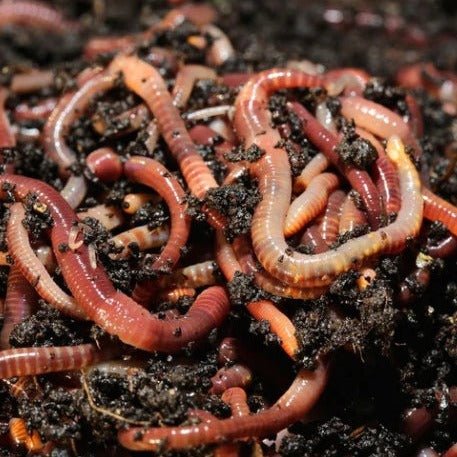The Secret to Lush Lawns Starts with Red Wiggler Express Lawn Care Services
The Secret to Lush Lawns Starts with Red Wiggler Express Lawn Care Services
Blog Article
Red Wigglers: The Unsung Heroes of Organic Waste Recycling
Red wigglers, or Eisenia fetida, serve as crucial agents in the natural waste recycling procedure, changing discarded products into important vermicompost. As the world increasingly seeks remedies to deal with waste build-up and improve agricultural productivity, recognizing the function of these worms becomes necessary.
What Are Red Wigglers?
The impressive durability of red wigglers, scientifically called Eisenia fetida, highlights their critical duty in organic waste recycling. These tiny, reddish-brown earthworms are normally located in decomposing organic matter, such as garden compost piles and manure loads. Lake Hickory Bait. Unlike various other earthworm varieties, red wigglers prosper in nutrient-rich atmospheres and are very efficient at damaging down organic products, making them vital for vermicomposting

(Red Wiggler Express)In addition to their function in waste decrease, red wigglers add to dirt health and wellness by boosting soil structure and aeration through their delving tasks (Lake Hickory Bait). Their presence in composting systems not only improves disintegration prices however additionally advertises a sustainable method to throw away management, illustrating their value in eco-friendly preservation initiatives
Benefits of Composting With Worms
Composting with worms, especially red wigglers, provides many advantages that improve both waste management and dirt wellness. First, these worms efficiently damage down natural waste, converting it right into nutrient-rich vermicompost that improves dirt. This process increases decomposition, enabling a faster recycling of kitchen scraps and various other organic products contrasted to standard composting techniques.
Furthermore, the vermicompost produced by red wigglers is bristling with useful bacteria, which assist improve soil structure, aeration, and moisture retention. This boosts the total health and wellness of plants, promoting vigorous development and boosted yields in gardens and agricultural settings. Additionally, making use of worms in composting decreases the manufacturing of greenhouse gases, such as methane, adding to a much more lasting waste monitoring system.

How to Start Vermicomposting
Developing a vermicomposting system is a simple procedure that can yield substantial advantages for both waste monitoring and dirt enrichment. To begin, select an ideal container, such as a plastic container or wooden box, with appropriate air flow holes to ensure correct airflow. The dimensions should ideally be around 2 feet by 3 feet, enabling adequate room for the worms to grow.
Next, prepare bedding material, which can consist of shredded paper, cardboard, or coconut coir. This bed linen must be moistened to produce an appropriate habitat for the worms. Once the bed linen is in place, introduce red wigglers (Eisenia fetida) right into the container, generally around one pound of worms for every square foot of surface area.
Following the placement of worms, include organic waste, such as fruit and vegetable scraps, coffee grounds, and crushed eggshells. With these actions, you will successfully initiate a vermicomposting system that adds to lasting waste administration and enriches your dirt.
Maintaining a Healthy And Balanced Worm Bin
(Red Wiggler Express)Maintaining a worm bin growing needs regular interest and like make certain the health and wellness of the red wigglers and the performance of the composting process. Proper maintenance begins with monitoring the wetness levels; the container must be moist yet not saturated. A good policy of thumb is to preserve a consistency comparable to a wrung-out sponge.
Oygenation is important as well. Carefully mixing the bed linen and food scraps every couple of weeks avoids compaction and makes certain that all worms have access to oxygen. In addition, it is necessary to feed the worms suitably. A balanced diet plan of vegetables and fruit scraps, coffee premises, and crushed eggshells must be offered in moderation to prevent overfeeding, which can bring about odors and bugs.
Temperature guideline is an additional vital aspect. Red wigglers prosper in a variety of 55 to 77 levels Fahrenheit. If the container becomes too hot or chilly, the worms may end up being worried - Lake Hickory Bait. Occasionally examine for indicators of health, such as worm population growth and the presence of healthy and balanced spreadings. By diligently managing these elements, one can maintain a robust and productive worm container.
Effect On Lasting Living
The successful maintenance of a worm container not just profits the health of red wigglers yet additionally adds dramatically to sustainable living methods. By recycling organic waste, such as cooking area scraps and yard debris, red wigglers help draw away substantial amounts of material from garbage dumps. This reduction in waste not only reduces greenhouse gas discharges however additionally decreases the ecological concern connected with waste administration.
Moreover, the castings click here to read produced by red wigglers function as a nutrient-rich organic plant food, improving dirt health and advertising plant growth. This all-natural alternative to chemical plant foods sustains lasting agriculture and horticulture practices, minimizing reliance on artificial inputs that can hurt ecosystems. In addition, worm composting promotes awareness of waste administration, urging people and communities to embrace even more lasting practices.

Final Thought
In summary, red wigglers function as vital contributors to organic waste reusing via their efficient decomposition of organic materials. Their capacity to produce nutrient-rich vermicompost improves soil health and wellness and supports sustainable agricultural practices. By integrating vermicomposting into waste management techniques, individuals and areas can considerably decrease waste while promoting environmental sustainability. The role of Eisenia fetida in fostering healthy ecosystems underscores the significance of these organisms in achieving lasting living and improving dirt fertility.
Report this page